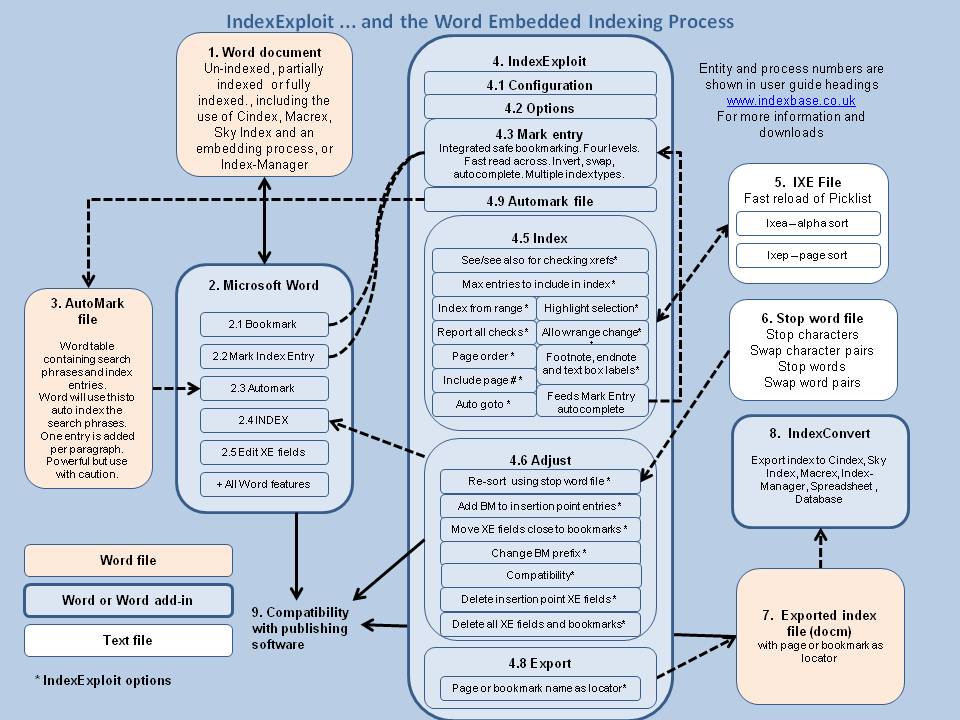
IndexExploit
IndexExploit is an add-in for creating and debugging Word embedded indexes.
If you are a professional indexer, or a Word user familiar with the Word indexing module, then IndexExploit provides facilities to make your indexing easier and more accurate.
Embedded index entries can be parsed and used to create an alphabetically ordered picklist. This is used to find content in your document, rather like using a linked index. It is the fastest way to link your index and will work with almost all word documents with embedded indexes. To create an index picklist simply select Index.
Conventional linked indexes can also be created. Hyperlinks or references can be used as links, with, or without page numbers. To turn any embedded index into a linked index, first run Adjust, then Index, then Export.
Page numbers in Word documents are can be turned into hyperlinks to find the pages in PDFs on a network or on the internet. This is especially useful for organisations with many years of bulletins, who now need to place them on the internet and make them available to members.
The IndexExploit macro, user guide, and other information are available on the  downloads page.
downloads page.
The Configuration form is for entering the licence key and selects either the Word embedded, PDF, or Options form.
Word Embedded
For Word embedded indexes, IndexExploit is used in combination with the Word indexing module. It can also be used to edit embedded indexes created by any of the processes used by professional indexers including WordEmbed, DexEmbed, ixmlEmbedder or Index-Manager.
The Options form configures IndexExploit to your needs. See the user guide for more information.
With Word embedded functionality selected, the Mark Entry form indexes bookmarked ranges and insertion points. Bookmarking and index entry are accomplished from the same form. Un-indexed bookmarked ranges can be found and indexed. Existing entries are exploited to enable autocomplete or a dropdown entry list. Document search supports interactive indexing. Case, whole word, and regular expressions are supported. Entries can be copied from a controlled list in another Word document. The same form can also be used to debug an existing embedded index
AutoMark automatically appends highlighted trigger clauses to a selected AutoMark file. This can be adjusted and used to automatically index the text using Word Automark. Insertion point XE fields can all be removed by IndexExploit allowing the process to be repeated until a satisfactory result is achieved.
Index creates a Picklist. It is can also check for index coverage and structural defects in the embeds. Defects are bookmarked and included in a defect report. The index content can be exported to a tab delimited file.
Picklist behaves like a hyperlinked index.
Entries and associated bookmarks are found and can be edited in the text or removed. Bookmarked ranges can be resized.
Careful selection of options allows several index variants to assist with debugging and editing.
- Full index
- Partial index based on a selected range
- Index to footnotes, endnotes and text boxes only
- Index limited to a chosen number of entries
Adjust is an automated process enabling the following changes to the embedded index entries.
- Alter sort overrides in embedded entries by reference to a stop word file.
- Alter insertion point embeds to range embeds.
- Move XE fields close to referenced ranges
- Alter bookmark prefixes and update referencing XE fields
- Delete all insertion point XE fields (Complements AutoMark)
- Delete all XE fields and referenced bookmarks
Export creates a separate Word file.
When Adjust has been used to alter insertion point embeds to range embeds, the following options are effective.
Options include
Page number separator, default in en dash
Add IndexConvert labels, enabling import to indexing software
Copy fonts and styles, copies fonts and styles from the Word index. The default is a plain text export from the IndexExploit database.
Link entries to bookmarks with hyperlinks
Link entries to bookmarks with references
Insert labels and note numbers
The result also depends on whether page numbers are included when generating the picklist.
a. Locators as hyperlinks
Without page numbers. Locators are shown as ( 1 ), ( 2 ), ( 3 )
With page numbers. Locators are shown as 101, 105-106, 222 Page numbers in the index are unchanged when the document is reflowed/repaginated, a new index file must be inserted
b. Locators as references, with or without page numbers. The exported index, when copied to the indexed document, links to content using updating page numbers.
Locators are displayed as 101, 105 (5), 222 etc. where (...) is the range as paragraphs. Page numbers update when document reflow/repaginate occurs.
.
Export enables a wide variety of linked index formats for digital publications. When the process is completed the Word document can be converted to a PDF where links remain live.
PDFs
With PDF functionality selected an index in a Word file is used to navigate to the PDF page. A single document or a suite of documents can be used.
Acrobat Pro DC or equivalent is required for PDFs on a computer or network. Nothing else is required if the files are on the Internet or an intranet.
Utilities
Hyperlinks table finds hyperlinks and exports screen display and hyperlink information to a table in a new document.
See the  downloads page for the user guide and to download IndexExploit.
downloads page for the user guide and to download IndexExploit.